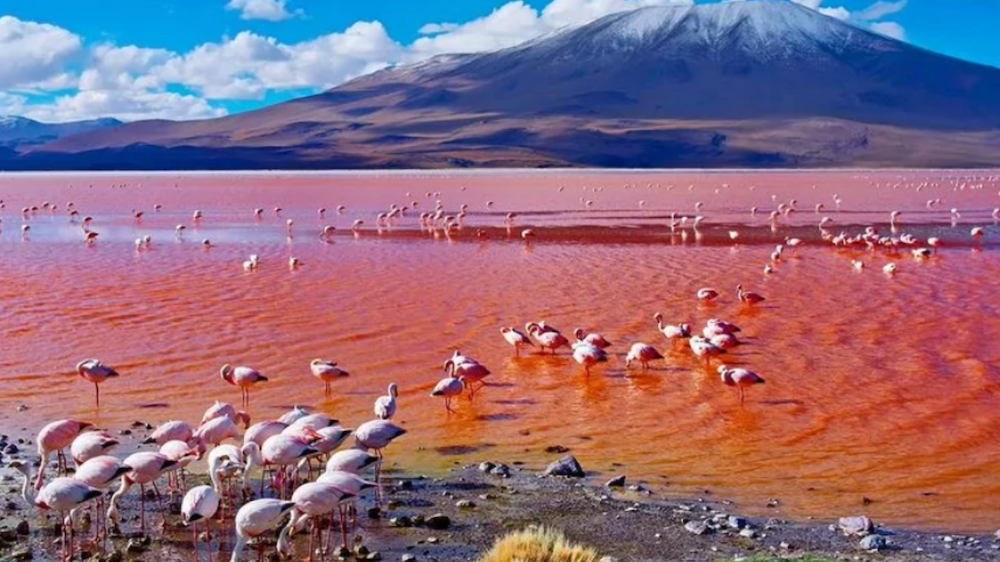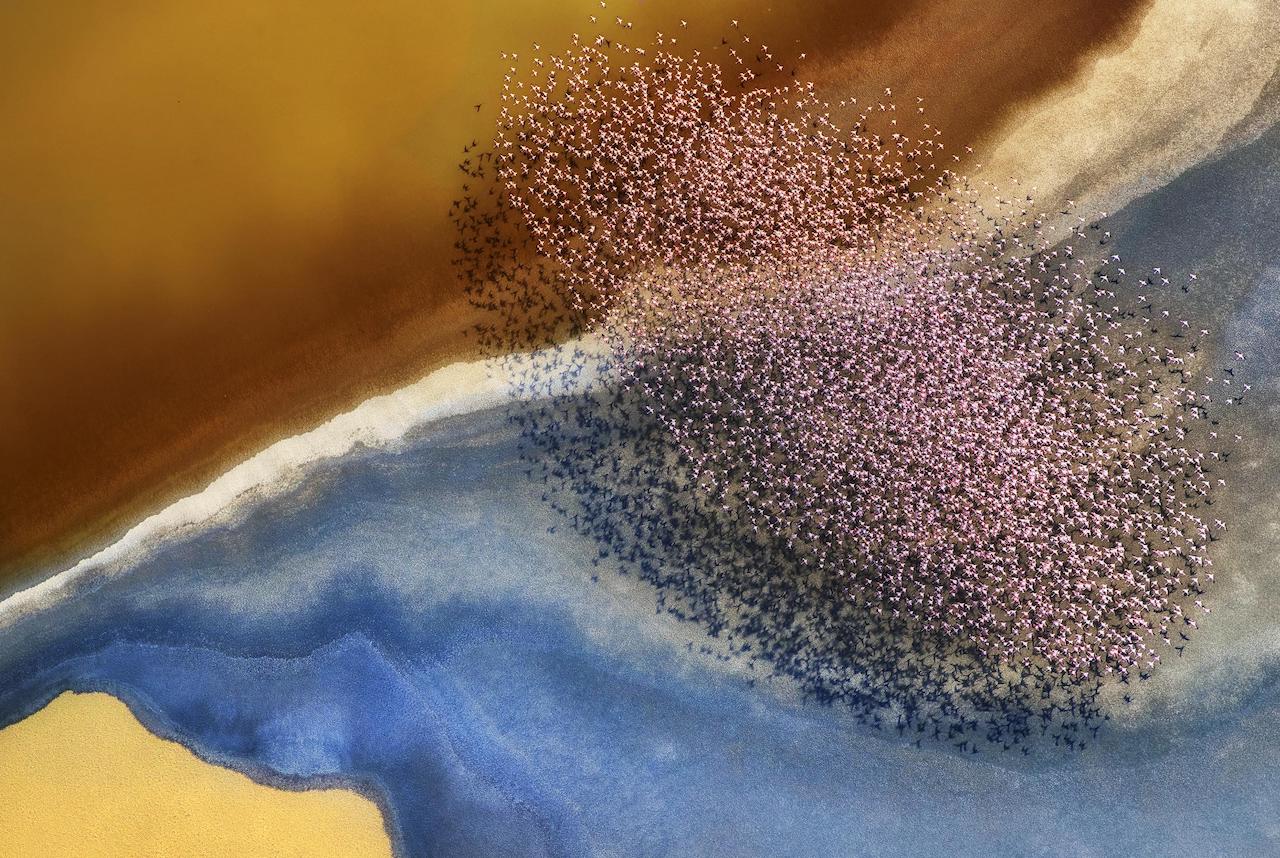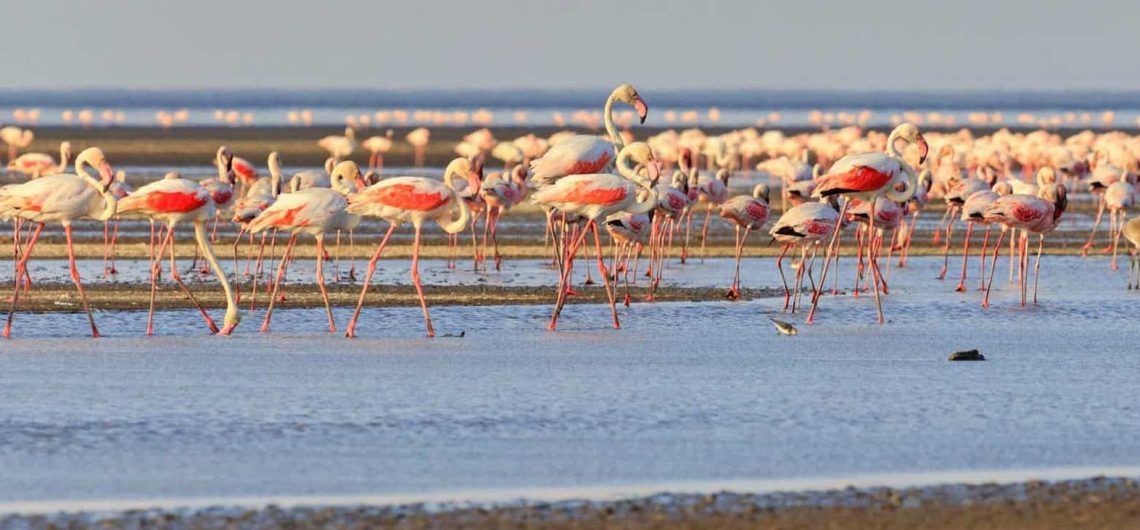Are you interested in visiting Tanzania and flamingoes are among the must sees for you? This is a comprehensive guide on the Flamingo safaris in Tanzania, the best time to see flamingoes in Tanzania, and the best places to spot flamingoes while travelling in Tanzania.
A breathtaking scene unfolds as numerous elegant creatures with tall, pink feathers and slender legs gracefully inhabit the shores of the lake. It is nearly impossible to overlook the presence of flamingos, and their remarkable beauty is truly captivating. Fortunately, there are several regions throughout Africa where one can witness vast gatherings of pink flamingos in their natural environment, particularly in East and Southern Africa. Therefore, it begs the question: can flamingos be found in Tanzania? The answer is yes, as Tanzania serves as a home to millions of wild pink flamingos. The crater lakes in Tanzania and the shores of the Rift Valley soda lakes provide excellent habitats for these migratory birds. The most ideal locations to observe flocks of flamingos in Northern Tanzania include Lake Manyara, Lake Natron, Empakai Crater, Lake Magadi in Ngorongoro Crater, Lake Ndutu, and Momela Lakes in Arusha National Park. Among the six flamingo species worldwide, Africa is home to only two: the Greater flamingo and the Lesser flamingo. Tanzania is fortunate to have both species in abundance, and they typically coexist and migrate together in colonies ranging from hundreds to thousands of individuals. Distinguishing between the two species is relatively simple, primarily by comparing their respective heights.
Types of flamingoes found in Tanzania
There are two main types of flamingoes in Tanzania. Both flamingo types are found in the different lakes that are found mainly in The Northern Tanzania safari circuit, where most visitors visit for unforgettable Tanzania safari.
The Greater flamingo
The Greater flamingo, scientifically known as Phoenicopterus roseus, holds the distinction of being the tallest among all flamingo species. On average, adult Greater flamingos measure between 1 to 1.5 meters in height. In terms of weight, they typically range from 1.8 to 4 kilograms. Additionally, their wingspan spans from 1.4 to 1.8 meters in length.
The Lesser Flamingo
Referred to as the Lesser flamingo (Phoeniconaias minor), these birds are easily distinguished by their smaller size and stature compared to the Greater flamingos. On average, Lesser flamingos stand at a height ranging from 95 to 110 centimeters. Their weight typically falls between 1.1 to 2.6 kilograms. In Tanzania, much like the rest of Africa, the population of flamingos is primarily composed of Lesser flamingos. It is worth noting that the striking pink coloration of flamingos is believed to be a result of their diet, specifically the consumption of Blue-green algae or Spirulina. The more they consume these algae, the more vibrant their pink hues become!
The Ideal Time to Observe Flamingos in Tanzania
Flamingos can be observed in Tanzania throughout the year. Whenever you visit Tanzania, there are favorable opportunities to witness these elegant birds around the numerous soda lakes. However, the peak season for flamingos in Tanzania occurs from November to May. During this period, you can witness the impressive gatherings of pink flamingos that Tanzania is renowned for. Outside of the peak season, flamingos are less abundant and tend to congregate towards the center of the lakes. As migratory birds, they move between various soda lakes in Tanzania during this time. Therefore, the optimal time to observe large numbers of flamingos in each location depends on their migratory patterns. If you desire to witness thousands of these magnificent creatures, it is advisable to consider their migratory behavior and plan accordingly.
Factors Influencing Flamingo Sightings and their Migratory Patterns in Tanzania
The presence and abundance of flamingos in specific locations in Tanzania are determined by several key factors. These factors play a role in dictating when, where, and in what numbers these captivating birds can be observed. The following are the primary factors influencing flamingo sightings:
-
Availability of Food:
Wild flamingos primarily rely on algae and brine shrimp as their main sources of sustenance. These vital food sources thrive in mineral-rich waters found in alkaline lakes. When changes in climate or other factors disrupt the salinity of a lake, inhibiting algae growth, the habitat becomes unsuitable for flamingos. Consequently, flamingos embark on migratory journeys to seek out alternative saline lakes where sufficient food is available.
-
Fluctuating Lake Water Levels:

The rise and fall of water levels in a lake directly impact its salinity, which in turn affects the survival of algae and shrimp—the primary food sources for flamingos. When water levels rise, the salinity diminishes, creating an unfavorable environment for algae and shrimp. Conversely, when water levels recede, the lake becomes more acidic, leading to the demise of these vital organisms. The loss of algae and shrimp in a lake directly translates to the loss of flamingos as they seek out alternative habitats with suitable conditions.
-
Breeding Season:
During the breeding season, flamingos undertake significant migrations to reach their preferred breeding grounds. In Tanzania, Lake Natron serves as the principal breeding ground for flamingos. During this period, a substantial portion of the flamingo population migrates to Lake Natron for mating, nesting, hatching, and breeding activities. They typically spend approximately 3 to 4 months in this location before further migration to other saline lakes in East Africa, such as Lake Manyara in Tanzania and Lake Bogoria in Kenya.
Understanding these factors provides insight into the movements and patterns of flamingos in Tanzania. By considering the availability of food, fluctuations in lake water levels, and the breeding season, one can better plan their visit to witness the mesmerizing sight of flamingos in their natural habitats.
Top Locations and Optimal Times to Spot Wild Flamingos in Tanzania
-
Lake Natron
Lake Natron, located in Northern Tanzania, is the largest breeding ground for Lesser flamingos in Africa. The best time to observe flamingos here is between September and December. September marks the nesting and egg-laying period, while November to December is when the hatching takes place. December is considered the prime time due to the high number of hatched chicks. Lake Natron’s alkaline waters and abundance of spirulina make it an ideal habitat for flamingos.
-
Lake Manyara
Situated within Lake Manyara National Park, Lake Manyara itself is a saline lake known for its diverse bird species. From May to July, hundreds of thousands of flamingos gather here. The lake spans 230 square kilometers and reaches a depth of 3.6 meters. It serves as an important water source for wildlife and is recognized as a Biosphere Reserve.
-
Lake Magadi (Lake Makat)
Lake Magadi, also known as Lake Makat, is located within the Ngorongoro Crater. This seasonal lake provides a habitat for pink-hued flamingos. The best time to see them is from November to May, during Tanzania’s wet season. The high density of blue-green algae in the crater attracts many flamingos. The swamps, springs, and watering holes in the area also offer opportunities for spotting these birds.
-
Momella Lakes
 Found in Arusha National Park, the Momella Lakes consist of seven shallow alkaline lakes, including Big Momella and Small Momella. During the wet season, these lakes attract thousands of Lesser and Greater flamingos to their shores. Small Momella Lake, with its shallower depth, tends to have the highest concentration of flamingos.
Found in Arusha National Park, the Momella Lakes consist of seven shallow alkaline lakes, including Big Momella and Small Momella. During the wet season, these lakes attract thousands of Lesser and Greater flamingos to their shores. Small Momella Lake, with its shallower depth, tends to have the highest concentration of flamingos.
-
Empakaai Crater
Empakaai Crater, located within the Ngorongoro Conservation Area, offers a picturesque setting for flamingo sightings. The soda ash-crusted shores of Empakaai Lake draw flamingos searching for algae, particularly when Lake Magadi starts drying up. You can hike down the volcanic caldera to reach the lake.
-
Lake Ndutu
Situated on the eastern edge of Serengeti National Park, Lake Ndutu is known for its spectacular flamingo migration. From June to November, large flocks of flamingos can be observed on the shores of this small soda lake. Lake Ndutu however is not located within the Serengeti National Park, but rather on the Ngorongoro Conservation Area side; the Ndutu Plains where the breeding and calving of wildebeests takes place every year between the months of December and the end of February. Both Greater and Lesser flamingos frequent this location.
-
Lake Eyasi
Lake Eyasi, located near the Ngorongoro Conservation Area, is a seasonal lake that remains dry for most of the year. However, during the wet season, when the lake comes to life, it offers an opportunity to see flamingos in the wild. The best time for flamingo sightings is during the wet season.
To maximize your chances of spotting flamingos, visit Tanzania during the wet season, particularly in November, December, and May. These months coincide with the short rain season and the end of the rainy season, providing optimal conditions for flamingo viewing. As most prime flamingo destinations are within Tanzania’s Northern Circuit, you can easily combine flamingo watching with wildlife safaris. Contact our Safari Specialists to customize the best trip for you and experience the captivating sight of flamingos flocking in Tanzania.


Comments